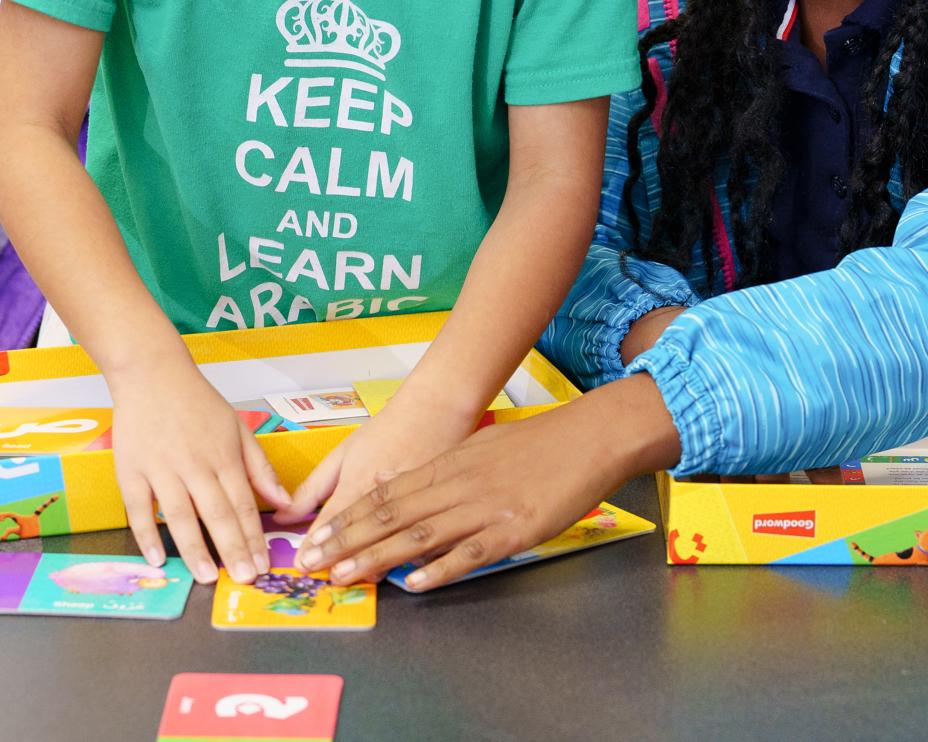
Something went Wrong
Try entering your email again or contact us at support@qfi.org
Try entering your email again or contact us at support@qfi.org
You’ll receive an email with a confirmation link soon.
Oct 14, 2025
By Rima Nasser
From technology and media to social interactions, English dominates their world, leaving little room for Arabic to thrive. Schools, often prioritizing English proficiency, inadvertently reinforce this imbalance, making Arabic feel like a difficult subject rather than a living, breathing language. This linguistic shift has had a profound impact on how Arabic is learned, practiced, and perceived by young learners. The result? Students struggle, teachers feel overwhelmed, and the love for Arabic fades.
But it doesn’t have to be this way.
The Influence of Environment
Our students are growing up surrounded by English. From smartphones to social media, from movies to classroom instruction—English is the default language. As a result, Arabic is often sidelined, even at home. Many children have few, if any, opportunities to hear, speak, or meaningfully engage with Arabic in their daily lives. When every device, show, and game defaults to English, the language becomes confined to textbooks.
This exposure imbalance makes learning Arabic feel foreign and disconnected, even to native speakers. The language becomes something "hard" or "boring," rather than a living, breathing part of their identity.
Challenges Within the School System
Schools tend to prioritize English in instruction and resources, which reinforces the perception that Arabic is less important or more difficult. Moreover, Arabic curricula are often not adapted to reflect students’ real language environments. In many classrooms, teachers are under pressure to cover dense curricula, administer standardized tests, and produce grades.
This pressure creates a cycle:
In short, many students are not learning how to use Arabic—they’re just learning how to pass. Traditional rote learning drains the joy from Arabic. Without interactive, engaging lessons, students disengage, seeing it as a chore rather than a skill to master.
If we want our students to succeed, we must shift our approach—starting as early as kindergarten. We must build a strong linguistic foundation that enables children to read and comprehend Arabic independently.
Imagine a classroom where:
This kind of learning environment allows students to build confidence and joy in using their native language. It empowers them to think critically and creatively, just as they do in English.
One of the key differences between Arabic and English instruction is the element of fun. English classes often include songs, interactive centers, role-playing, storytelling, and games. These methods not only enhance language retention but also nurture a love for the subject.
Arabic instruction should be no different.
Ideas for More Engaging Arabic Lessons:
When students enjoy the process of learning Arabic, the language becomes less of a burden and more of a personal victory.
We must reimagine Arabic education by making it active, enjoyable, and meaningful. Here’s how:
1. Start Strong in Early Years
2. Student-Centered Learning
3. Empower, Don’t Overwhelm
4. Make Arabic Irresistible
Why should English have all the fun? Use:
I urge every Arabic educator to pause and reflect:
Let’s teach in a way that leaves a lasting impression—not just in test scores, but in hearts and minds. Let’s build strong foundations so that our students can thrive not just in the classroom, but in life.
In Conclusion
Our goal as Arabic teachers should not be limited to covering a curriculum or submitting grades.
Our mission is to:
If we make Arabic learning fun, relevant, and rooted in strong early foundations, there’s no doubt in my mind that our students will rise to the challenge—and even begin to compete with English in their daily lives. Helping our students master their mother tongue means they’ll carry that pride for life.
A love for Arabic begins where lessons come alive—fueled by the teacher’s imagination and the student’s curiosity, taught with passion, and learned with joy. This will help raise a generation that doesn’t just speak Arabic—but lives it.
Disclaimer: The views and opinions expressed in this blog are those of the author and do not necessarily reflect the views of Qatar Foundation International (QFI). While QFI reviews guest contributions for clarity and to ensure the content is valuable for our audience, the accuracy and completeness of the information are the responsibility of the author.
Submit Your Own Blog!
We invite educators, researchers, and professionals in Arabic education to share their insights with our global community. Whether you teach, conduct research, or support Arabic language learning, your voice can spark innovation, drive change, and deepen understanding in the field of Arabic education.
With 25+ years of experience in Arabic language education, I am deeply passionate about teaching and inspiring young minds. My greatest joy comes from fostering meaningful connections with students and seeing their curiosity and understanding grow. Teaching is not just a profession but a calling, driven by dedication and a love for nurturing the next generation.



